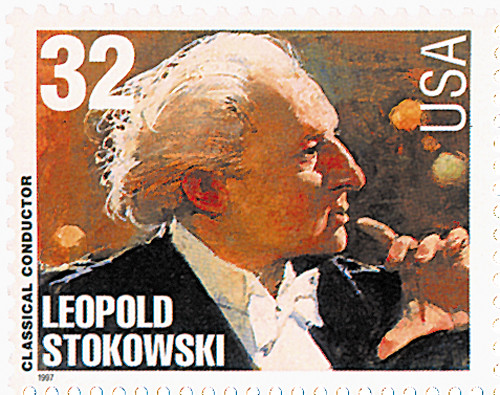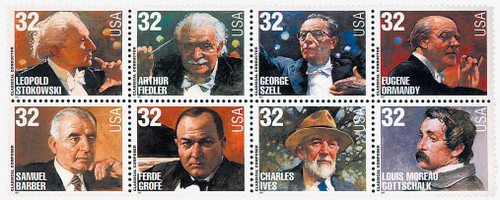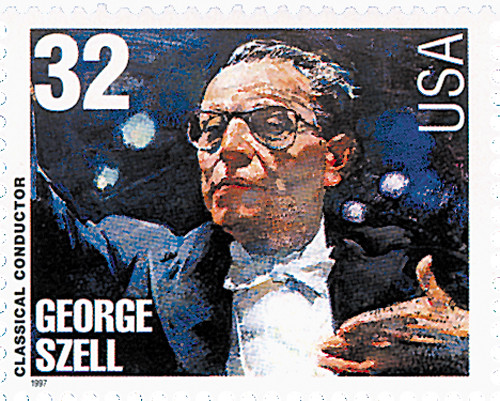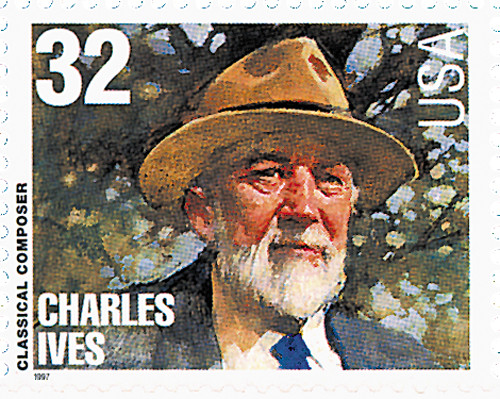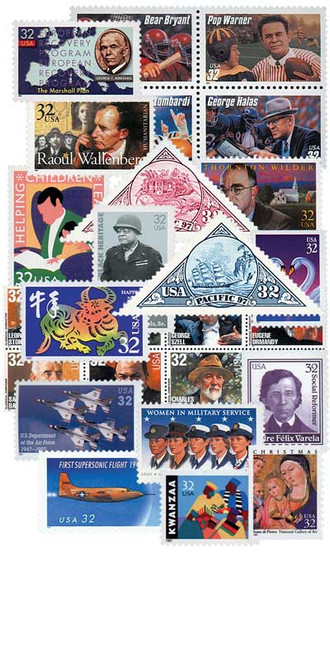
# 3161 - 1997 32c Conductors and Composers: Eugene Ormandy, Conductor
US #3161
1997 Eugene Ormandy – Classical Composers & Conductors
American Music Series
- Pictures conductor Eugene Ormandy
- Part of the Classical Composers & Conductors set
- The 10th stamp set in the Legends of American Music series
Stamp Category: Commemorative
Set: Classical Composers & Conductors
Series: Legends of American Music
Value: 32¢, First Class Mail Rate
First Day of Issue: September 12, 1997
First Day City: Cincinnati, Ohio
Quantity Issued: 86,000,000
Printed by: Printed for Ashton Potter (USA) Ltd. By Sterling Sommer of Tonawanda, New York
Printing Method: Offset
Format: Pane of 20 (Horizontal 4 across, 5 down)
Perforations: 11.1 by 11.0
Tagging: Phosphored paper
Why the stamp was issued: To commemorate conductor Eugene Ormandy, one of the best of the best in American classical music.
About the stamp design: The stamp pictures a painting of Ormandy by artist Burt Silverman (also responsible for the image on the 1997 Raoul Wallenberg stamp). Art director Howard Paine said he chose Silverman because “He is a mature portrait painter… I didn’t want some glitzy, commercial, airbrush, flashy, tightly rendered kind of art…. Burt’s work is ‘painterly.’ He works in oil, and you can see dabs of color and you see brush strokes and you see the human touch.”
First Day City: The First Day of Issue Ceremony for the Classical Composers & Conductors stamps was held in Cincinnati, Ohio, at the Classical Music Hall of Fame. The city is also home to the Cincinnati Symphony Orchestra, then the fifth oldest symphony orchestra in the United States. It is also home to the Cincinnati Opera, the country’s second-oldest opera company.
About the Classical Composers & Conductors set: Issued to commemorate composers Samuel Barber, Ferde Grofe, Charles Ives, and Louis Moreau Gottschalk, as well as conductors Leopold Stokowsky, Arthur Fiedler, George Szell, and Eugene Ormandy. They were chosen to represent the best of the best in American classical music.
About the Legends of American Music Series: The Legends of American Music Series debuted on January 8, 1993, and ran until September 21, 1999. More than 90 artists are represented from all styles of music: rock ‘n’ roll, rhythm and blues, country and western, jazz and pop, opera and classical, gospel and folk. In addition to individual singers and Broadway musicals, subjects include band leaders, classical composers, Hollywood songwriters and composers, conductors, lyricists, and more. The Legends of American Music Series was a huge advancement for diversity because it honored many Black and female artists.
History the stamp represents: Born in Hungary, Eugene Ormandy (1899-1985) gave his first performance as a violinist at the age of seven. By age 17, he had been appointed a professor of the violin and was successfully touring Europe. A trip to New York in 1921 (for a tour which never materialized) forced him to take work with a theater symphony that accompanied silent movies and provided musical interludes. Quickly moving to first violin, Ormandy made his conducting debut there in 1924.
Ormandy became an American citizen in 1927. At that time, he focused his attention on conducting programs of lighter classical music for use in the new medium of radio. In 1930, he began conducting the Philadelphia Orchestra, and from 1938 until 1980, he served as the orchestra’s sole musical director. In 1948, Ormandy conducted the first symphony to be broadcast on American television. Under his leadership, the Philadelphia Orchestra toured many countries and made many recordings.
Ormandy specialized in performances of romantic and neo-romantic music. He often emphasized fine string playing and rich, saturated orchestral tones, causing critics to describe his orchestra’s sound as “voluptuous.”
US #3161
1997 Eugene Ormandy – Classical Composers & Conductors
American Music Series
- Pictures conductor Eugene Ormandy
- Part of the Classical Composers & Conductors set
- The 10th stamp set in the Legends of American Music series
Stamp Category: Commemorative
Set: Classical Composers & Conductors
Series: Legends of American Music
Value: 32¢, First Class Mail Rate
First Day of Issue: September 12, 1997
First Day City: Cincinnati, Ohio
Quantity Issued: 86,000,000
Printed by: Printed for Ashton Potter (USA) Ltd. By Sterling Sommer of Tonawanda, New York
Printing Method: Offset
Format: Pane of 20 (Horizontal 4 across, 5 down)
Perforations: 11.1 by 11.0
Tagging: Phosphored paper
Why the stamp was issued: To commemorate conductor Eugene Ormandy, one of the best of the best in American classical music.
About the stamp design: The stamp pictures a painting of Ormandy by artist Burt Silverman (also responsible for the image on the 1997 Raoul Wallenberg stamp). Art director Howard Paine said he chose Silverman because “He is a mature portrait painter… I didn’t want some glitzy, commercial, airbrush, flashy, tightly rendered kind of art…. Burt’s work is ‘painterly.’ He works in oil, and you can see dabs of color and you see brush strokes and you see the human touch.”
First Day City: The First Day of Issue Ceremony for the Classical Composers & Conductors stamps was held in Cincinnati, Ohio, at the Classical Music Hall of Fame. The city is also home to the Cincinnati Symphony Orchestra, then the fifth oldest symphony orchestra in the United States. It is also home to the Cincinnati Opera, the country’s second-oldest opera company.
About the Classical Composers & Conductors set: Issued to commemorate composers Samuel Barber, Ferde Grofe, Charles Ives, and Louis Moreau Gottschalk, as well as conductors Leopold Stokowsky, Arthur Fiedler, George Szell, and Eugene Ormandy. They were chosen to represent the best of the best in American classical music.
About the Legends of American Music Series: The Legends of American Music Series debuted on January 8, 1993, and ran until September 21, 1999. More than 90 artists are represented from all styles of music: rock ‘n’ roll, rhythm and blues, country and western, jazz and pop, opera and classical, gospel and folk. In addition to individual singers and Broadway musicals, subjects include band leaders, classical composers, Hollywood songwriters and composers, conductors, lyricists, and more. The Legends of American Music Series was a huge advancement for diversity because it honored many Black and female artists.
History the stamp represents: Born in Hungary, Eugene Ormandy (1899-1985) gave his first performance as a violinist at the age of seven. By age 17, he had been appointed a professor of the violin and was successfully touring Europe. A trip to New York in 1921 (for a tour which never materialized) forced him to take work with a theater symphony that accompanied silent movies and provided musical interludes. Quickly moving to first violin, Ormandy made his conducting debut there in 1924.
Ormandy became an American citizen in 1927. At that time, he focused his attention on conducting programs of lighter classical music for use in the new medium of radio. In 1930, he began conducting the Philadelphia Orchestra, and from 1938 until 1980, he served as the orchestra’s sole musical director. In 1948, Ormandy conducted the first symphony to be broadcast on American television. Under his leadership, the Philadelphia Orchestra toured many countries and made many recordings.
Ormandy specialized in performances of romantic and neo-romantic music. He often emphasized fine string playing and rich, saturated orchestral tones, causing critics to describe his orchestra’s sound as “voluptuous.”







